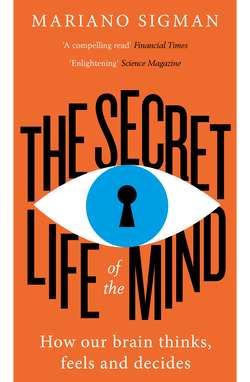Читать книгу The Secret Life of the Mind: How Our Brain Thinks, Feels and Decides - Mariano Sigman - Страница 30
Turing in the supermarket
ОглавлениеEven though in the laboratory we study simple decisions, what we are ultimately more interested in revealing is how the brain makes everyday decisions: the driver who decides whether or not to jump an amber light; the judge who condemns or exonerates a defendant; the voter who casts a ballot for one candidate or another; the shopper who takes advantage of or falls victim to a special deal. The conjecture is that all of these decisions, despite belonging to different realms and having their own idiosyncrasies, are the result of the same decision-making mechanism.
One of the main principles of this procedure, which is at the heart of Turing’s design, consists in how one realizes when it is time to stop gathering evidence. The problem is reflected in the paradox described by a medieval philosopher, Jean Buridan: a donkey hesitates endlessly between two identical piles of hay and, as a result, ends up dying of hunger. In fact, the paradox presents a problem for Turing’s pure model. If the number of votes in favour of each alternative is identical, the cerebral race is stuck in a tie. The brain has a way of avoiding the tie: when it considers that sufficient time has passed, it invents neuronal activity that it randomly distributes among the circuits that codify each option. Since this current is random, one of the options ends up having more votes and, as such, wins the race. It’s as if the brain tossed a coin and let fate break the tie. How much time is reasonable for making a decision depends on internal states of the brain – for example, if we are more or less anxious – and on external factors that affect how the brain counts the time.
One of the ways that the brain estimates time is simply by counting pulses: steps, heartbeats, breaths, the swinging of a pendulum or music’s tempo. For example, when we exercise, we mentally estimate a minute faster than when we are at rest, because each heartbeat – and therefore each pulse of our inner clock – is quicker. The same happens with tempo in music. The clock accelerates with the rhythm and, thus, time passes more rapidly. Do these changes in our internal clock make us decide more quickly and lower our decision threshold?
Indeed, music has much more direct consequences for our decisions than we recognize. We drive, shop and walk differently depending on the music we are listening to at the time. As the musical tempo rises, our decision-making threshold lowers and as a result risk increases in almost every decision. Drivers change lanes more frequently, go through more amber lights, overtake and exceed the speed limit more while driving as the speed of the music they are listening to increases. Musical tempo also dictates the amount of time we are willing to wait patiently in a waiting room or the number of products we tend to buy in a supermarket. Many supermarket managers know that the piped-in music is a key to sales and use that to their advantage, with no need to be familiar with Turing’s work. That’s how predictable our decision-making machine is, yet we are almost completely unaware of its workings.
Another key factor that affects the decision-making machine is determining where the race begins. When there is a bias towards one of the alternatives, the neurons that accumulate information in its favour start with an initial electrical charge, which is similar to giving them a head start in the race. In some cases, biases can have a fundamental influence; for example, in the decision to donate organs.
Demographic studies of organ donation group different countries into two classes: those in which almost all the inhabitants agree to donate organs, and another in which almost no one does. It doesn’t take a master statistician to understand that what’s striking is the absence of intermediate classes. The reason turns out to be extremely simple: what ends up determining whether a person chooses to donate organs is the wording on the form. In the countries where the form says: ‘If you wish to donate organs, sign here’, no one does. On the other hand, in countries where it says: ‘If you do NOT wish to donate organs, sign here’, almost everyone donates. The explanation for both phenomena comes from an almost universal trait that has nothing to do with religion or life and death but rather just that no one fills out the form completely.
When we are offered a wide variety of options, they don’t all start running from the same point; those that are given by default begin with an advantage. If, in addition, the problem is one that is hard to resolve, meaning that evidence in favour of any of the options is scarce, the one that started out with the advantage wins. This is a very clear example of how governments can guarantee freedom of choice but, at the same time, bias – and, in practice, dictate – what we decide. But this also reveals a characteristic of human beings, be they Dutch, Mexican, Catholic, Protestant or Muslim: our decision-making mechanism collapses when faced with difficult situations. Then we merely accept what we are offered, by default.
